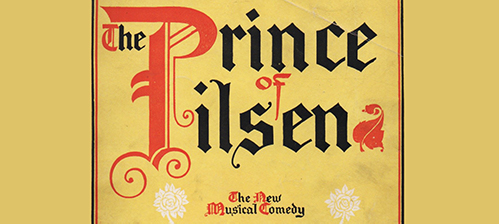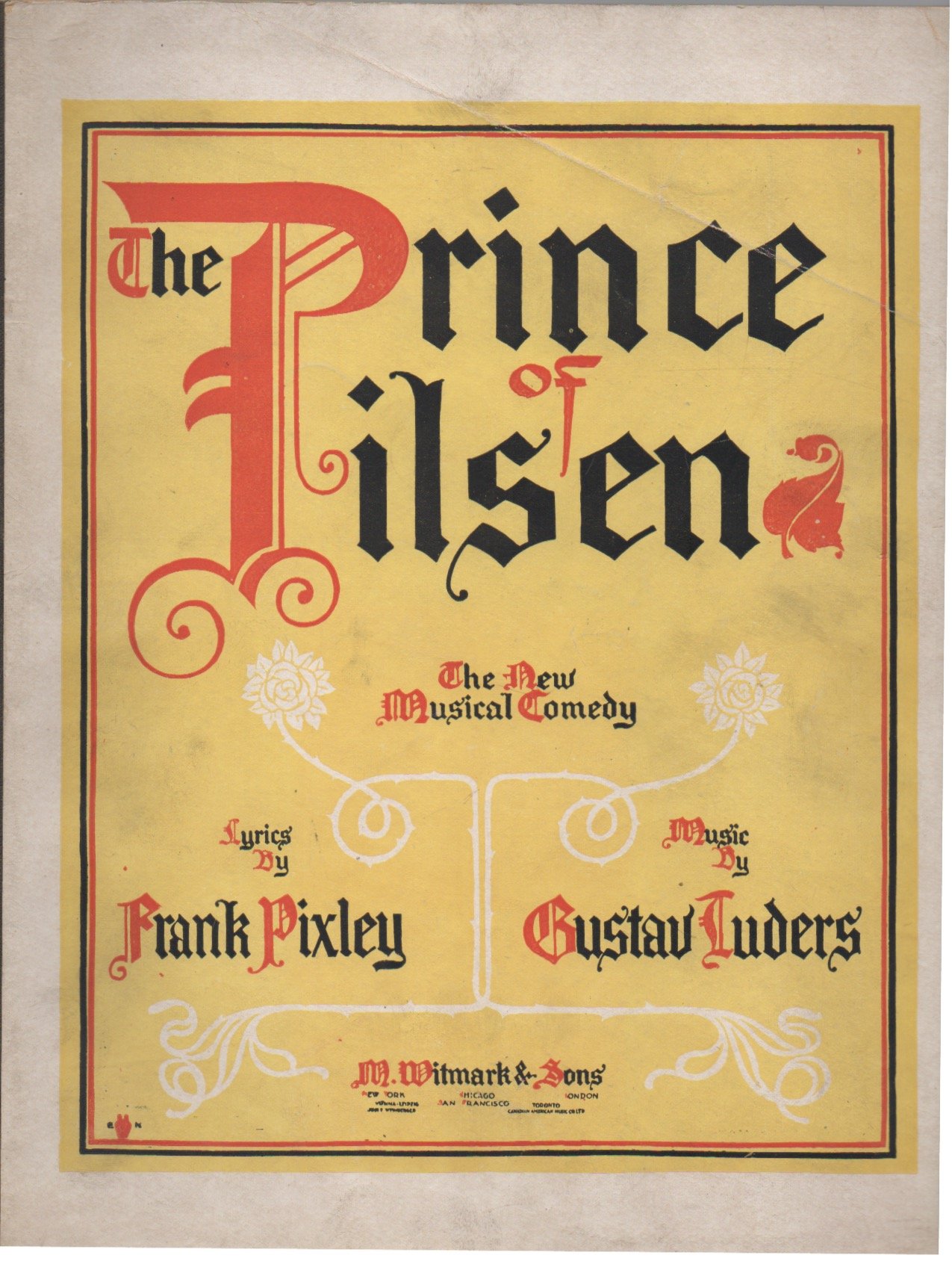
The German-born composer Gustav Luders (1865-1913) was firmly established in the U.S. when he teamed with librettist-lyricist Frank Pixley (1867-1919) to create The Prince of Pilsen in 1902. The musical comedy, the third of their seven collaborations, was the team's most successful undertaking.

Version 3
Prince of Pilsen (The) (1905-04-New York Theatre-Brodway)
Type de série: RevivalThéâtre: Loew's New York (Broadway - Etats-Unis) Durée : 1 mois Nombre : 40 représentationsPremière Preview : lundi 03 avril 1905Première : lundi 03 avril 1905Dernière : samedi 06 mai 1905Mise en scène : George Marion • Chorégraphie : Producteur :
Hans Wagner, a widowed brewer and alderman from Cincinnati, travels to Nice with his daughter, Nellie, in order to visit his son, Tom, who serves in the American Navy. The brewmaster, upon his arrival, is mistaken for the true Prince of Pilsen, Carl Otto. When the actual prince, who is studying in Heidelberg, appears with a group of his beer-loving friends, he decides to enjoy the blunder and ends up pursuing the Cincinnati brewer’s daughter. Tom, meanwhile, falls in love with Edith, a young woman from Vassar College, while Hans has his own romantic escapades with a wealthy American widow, Mrs. Crocker. Arthur St. John Wilberforce, Earl of Somerset, is the show’s antagonist; he is disappointed that Mrs. Crocker shows more interest in Hans than in him, for he is eager to access her fortune. A subplot finds Hans mistakenly possessing secret documents, but everything gets resolved once Carl Otto reveals his true identity.
The score, typical of the era, includes a variety of musical styles. “The Song of the Violet” is Edith and Tom’s luscious romantic waltz duet in Act 1 that in so many ways defines operetta. Hans’s “He Didn’t Know Exactly What to Do,” by contrast, is rooted in a musical comedy vein with its jaunty dotted rhythms and emphasis on the humorous text. Production numbers include “The American Girl,” in which Mrs. Crocker and the chorus celebrate the virtues of various American cities and their female inhabitants. Our modern separation of Ruritanian operetta from farcical musical comedy and spectacular revue disintegrates when looking at shows such as this, where multiple musical approaches sit comfortably alongside one another. (The vocal score, available at the University of Illinois, was published in 1902, before the show reached Broadway.)
One of the musical’s outstanding ensemble numbers, “The Heidelberg Stein Song,” demonstrates Luders’s ability to create local color with a strong dose of nostalgic sentiment. And as a drinking song, it is appropriately featured as this month’s homage to Oktoberfest. The number begins with a swaying 6/8 verse that celebrates student folly and a subsequent refrain that includes toasts to the homeland (“Here’s to the land that gave me birth”) and “to the girl I love.” With its nostalgia-tinged lyrics, the song appears to be intended as much for the Central European immigrants in the audience as for the youthful male chorus who sings it. The following section, faintly reminiscent of the popular student song “Gaudeamus igitur,” acknowledges that student days in Heidelberg are fleeting and must be savored: “Oh, Heidelberg, dear Heidelberg/Thy sons will ne’er forget/That golden haze/Of student days/Is round about us yet.” The sentimental ode remained popular with male glee clubs for decades.
If such affections and their exuberant presentation by a beer-drinking group of Heidelberg students seem familiar, it is because Sigmund Romberg and Dorothy Donnelly wrote the similarly themed “Drinking Song” for their 1924 blockbuster operetta The Student Prince in Old Heidelberg (or simply The Student Prince). The Student Prince was a musical version of Wilhelm Meyer-Foerster’s German-language play Alt Heidelberg, English translations of which played on Broadway as Heidelberg in 1902 and Old Heidelberg in 1903. The Prince of Pilsen landed in New York between these two luminous productions. Pixley and Luders drew on the popularity of the Heidelberg tale in creating their own student prince, modeling Carl Otto on Alt Heidelberg’s prince, Karl Heinrich (who becomes Karl Franz in The Student Prince). Here, though, the young royal gets to be with the girl he loves at the final curtain. This is a musical comedy, after all.
Hans, who speaks with a strong German accent (which Pixley wrote phonetically), represents the realization of the American dream. Though it is never explicitly stated, his speech patterns and mannerisms show him to be a German immigrant. Hans is extremely proud to be a naturalized American citizen, and as his daughter tells the real Prince of Pilsen: “He’s an American citizen — that’s the only title he ever had till to-day and the only one he wants.” Hans has become a successful businessman: he owns his own brewery in Cincinnati, and his public reputation is such that he was elected to serve as a city alderman. His son joined the Navy, and Hans Wagner, immigrant, has become an American through and through. He is proud of the city in which he lives, and theatergoers of the age often quoted his signature catch line, “Vos you effer in Cincinnati?”
One must wonder if Gustav Luders, the show’s composer, didn’t see a bit of himself in Hans Wagner. Luders, born in Bremen, Germany, arrived in America in 1888 and established a professional career first in Milwaukee as a conductor and then in Chicago as a composer. It was in Chicago that he met Frank Pixley, who was a working in the Windy City as a journalist. Like Hans Wagner, Luders found tremendous professional success and subsequent fame in the American Midwest.
The Prince of Pilsen opened in Boston at the Tremont Theatre in May 1902, and a script from this early version was deposited for copyright at the Library of Congress. Several musical changes occurred during the subsequent tryout period. “The Song of the Violet” was originally a solo for Edith in Act 2, and in the 1902 published vocal score, it had been transferred to Tom, still as a solo. Also changed is the opening verse-and-refrain section of what became “The Heidelberg Stein Song.” In the original, the male students call themselves “soldiers of love,” singing lines such as “The girls who have kissed us/We’ll not forget.” The revised opening, discussed earlier, is more nostalgic in tone than its slightly randy predecessor.
On March 17, 1903, The Prince of Pilsen had its Broadway premiere at the Broadway Theatre, then located at 41st Street. The show had a respectable 147-performance run and returned to New York annually until 1907. Its American cast travelled to London, where it gave 160 performances at the Shaftesbury Theatre. The Prince of Pilsen was featured in the Shubert’s series of older musicals that graced the Jolson Theatre in 1930, and the delightful musical comedy continued to be revived, often with revised libretti, until at least 1957.
Aucun dossier informatif complémentaire concernant Prince of Pilsen (The)

Version 1
Prince of Pilsen (The) (1903-03-Broadway Theatre-Broadway)
Type de série: OriginalThéâtre: Broadway Theatre (1445 Bway) (Broadway - Etats-Unis) Durée : 4 mois Nombre : 147 représentationsPremière Preview : mardi 17 mars 1903Première : mardi 17 mars 1903Dernière : samedi 18 juillet 1903Mise en scène : George Marion • Chorégraphie : Producteur : Avec : Jeannette Bageard, Helen Bertram, Lillian Coleman, Arthur Donaldson, Linford R. Jefferson, Anna Lichter, Clyde L. McKinley, Edgar Norton, Albert Parr, John H. Pratt, John W. Ransone, Francis Stuart, J. L. Sutherland, Henry Taylor, Sherman Wade, Eva Westcott

Version 2
Prince of Pilsen (The) (1904-04-Daly's Theatre-Brodway)
Type de série: RevivalThéâtre: Daly's Theatre (Londres - Angleterre) Durée : 4 semaines Nombre : 32 représentationsPremière Preview : lundi 04 avril 1904Première : lundi 04 avril 1904Dernière : lundi 02 mai 1904Mise en scène : George Marion • Chorégraphie : Producteur :

Version 3
Prince of Pilsen (The) (1905-04-New York Theatre-Brodway)
Type de série: RevivalThéâtre: Loew's New York (Broadway - Etats-Unis) Durée : 1 mois Nombre : 40 représentationsPremière Preview : lundi 03 avril 1905Première : lundi 03 avril 1905Dernière : samedi 06 mai 1905Mise en scène : George Marion • Chorégraphie : Producteur :

Version 4
Prince of Pilsen (The) (1906-03-Grand Opera House-Brodway)
Type de série: RevivalThéâtre: Grand Opera House (Broadway - Etats-Unis) Durée : 1 semaine Nombre : 27 représentationsPremière Preview : lundi 19 mars 1906Première : lundi 19 mars 1906Dernière : dimanche 01 avril 1906Mise en scène : George Marion • Chorégraphie : Producteur : Commentaires : Grand Opera House (Mar 19, 1906 - Mar 24, 1906)
New York Theatre (Apr 02, 1906 - Apr 1906)

Version 5
Prince of Pilsen (The) (1907-03-Academy of Music-Brodway)
Type de série: RevivalThéâtre: Academy of Music (Broadway - Etats-Unis) Durée : 2 mois 3 semaines Nombre : 32 représentationsPremière Preview : mercredi 06 mars 1907Première : mercredi 06 mars 1907Dernière : samedi 01 juin 1907Mise en scène : George Marion • Chorégraphie : Producteur :

Version 6
Prince of Pilsen (The) (1930-01-Jolson's 59th Street Theatre-Brodway)
Type de série: RevivalThéâtre: New Century Theatre (Broadway - Etats-Unis)
Durée : 1 semaine Nombre : 16 représentationsPremière Preview : lundi 13 janvier 1930Première : lundi 13 janvier 1930Dernière : samedi 25 janvier 1930Mise en scène : Milton Aborn • Chorégraphie : Producteur : Avec : Frances Baviello (Ensemble), Leonore Brody (Ensemble), India Cox (Mrs. Madison Crocker), Roy Cropper (Carl Otto), Carl DewsDene Dickens (Ensemble), Wee Griffin (Jimmy), Denis Gurney (Arthur St. John Wilberforce), Vivian Hart (Nellie Wagner), Clara Martens (Ensemble), Mona Moray (Ensemble), Robert O'Connor (Francois), Melvin Redden (Cook's Courier), Marjorie Seltzer (Sidonie), Al Shean (Mrs. Madison Crocker), Joseph Toner (Lieutenant Tom Wagner), Alice Wellman (Edith Adams)Commentaires : Le premier musical qui a ouvert dans les années '30 à Broadway…
Pas encore de video disponible pour ce spectacle

.png)
.png)




